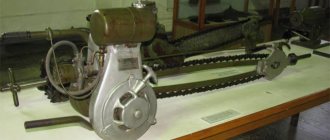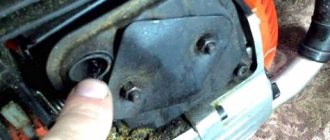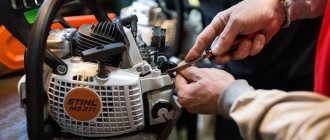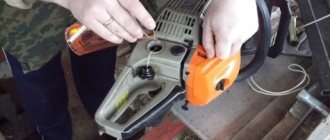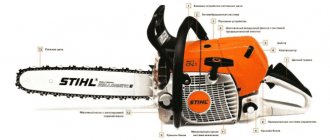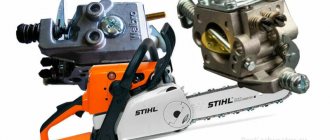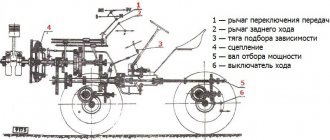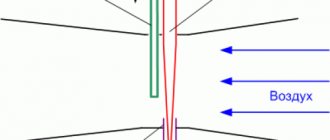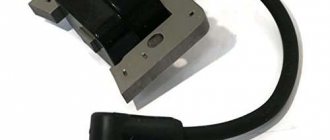Preparatory stage
Repair of any equipment must begin with the preparatory work stage, and the Stil 180 saw is no exception. At the preparatory stage, before disassembling the Shtil 180 chainsaw, it is necessary to remove the side cover, chain and tire from the chainsaw. Next, using a compressor and a brush, you need to clean the chainsaw from dirt, sawdust, oil stains and other things.
When cleaning the saw, special attention should be paid to the place where the chainsaw drive sprocket is located, since this is the most contaminated area.
In places where there is a large accumulation of oil, you can wash it with clean gasoline.
Malfunctions of the cutting set
A sufficiently lubricated and sharpened chain at the correct angle is one of the main advantages in the operation of Shtil petrol saws. During operation, the chain may jam, often due to clogged lubricant supply pipes or a breakdown of the fuel pump. When a chain becomes jammed, it often breaks, creating a risk of injury to the user. A circuit break can occur for other reasons:
- the lubricating fluid has run out or is not supplied in sufficient quantities;
- the driving or driven sprockets are worn out;
- foreign objects getting into the chain links;
- poor quality of the metal of the chain, or overheating of its teeth;
- operation of an unsuitable saw blade (chain).
It is very important to accurately maintain the sharpening angle of the chain. Not only does the cutting speed depend on this, but also its accuracy. The Stihl company produces a whole range of specialized sharpening machines for sharpening various types of chains in an automated mode.
Removing the handle
Direct disassembly of the Shtil 180 begins with removing the handle, which is attached to the chainsaw body using three rubber shock absorbers. To remove it, you need to remove the plastic plugs from the internal cavity of the shock absorbers, then using a powerful screwdriver, first press out the upper shock absorber, then the one closer to the rear handle.
At the rear of the handle there is a throttle trigger, which is connected to the carburetor through a wire rod; in order to disconnect the rod from the gas trigger, you need to unscrew two screws and disassemble the handle.
When the handle remains on one shock absorber, you need to unscrew the chainsaw body from the inside of the handle and, bending it to the side, remove the body from the last rubber band.
Product manufacturer STIHL
The history of the STIHL brand dates back to 1926, when Andreas Stihl founded.
Initially, the company specialized in creating working boilers and the first “washing machines”, and later, with the money earned, the first model of a chainsaw was created. This unit, despite its enormous weight (48 kg), quickly conquered the market and began to be sold very successfully to countries near and far abroad. The 90s marked the beginning of a family business for the company. Almost all members of the Stihl family began to take part in the life of the company.
In 1995, the AG&Co Holding was created, the main base of which was in Waiblingen and Diesburg.
Manufacturing company STIHL
Since 2002, a complete stranger has become the head of the board of directors of STIHL AG. At that time, boss Hans Peter Stihl headed the company's supervisory board and took over the chairmanship of the commission of STIHL Holding AG&Co.
After another 2 years, the company’s modern development center opened, and already in 2006, a new assembly plant started in China.
Today, the company is successfully developing, introducing new ideas and even more practical approaches into its work. STIHL's inventions top the chainsaw ratings in terms of reliability.
Removing the starter
At the next stage, the top housing cover is removed and the 4 starter mounting screws are unscrewed, after which it is necessary to remove the covers of the oil tank and fuel barrel. The starter is removed quite simply and there should be no problems.
After removing the starter, the opened internal cavity of the chainsaw must be cleaned, since there is usually a large amount of compressed small sawdust on the body under the starter.
Removing the flywheel
The flywheel of the Shtil 180 chainsaw is twisted with great force, so to remove it you will need a head with a metal knob. The nut holding the flywheel is unscrewed with a 13mm head.
To block the crankshaft from turning, you need to unscrew the spark plug and install a piston stopper through the spark plug hole; if there is none, you can use an old cord from the starter, with knots tied to it and immersed in the cylinder through the spark plug hole.
It is strictly forbidden to keep the flywheel from turning by installing a power screwdriver or other tools between its ribs and the body; with this method of blocking from turning, the flywheel blades are not able to withstand the load and break off.
Once the piston in the cylinder is locked, you can unscrew the flywheel nut. The thread in the nut is normal, so you need to turn it to the left. Having loosened the nut, you do not need to remove it completely; just unscrew it until its upper edge is level with the tip of the shaft, after which a soft metal drift is installed on the nut and a sharp blow is made on it. Thus, the flywheel jumps off the shaft from a sharp impact and can be easily removed without the help of additional tools.
Required special tools for repair
Before starting repair work on the Shtil chainsaw, you need to prepare the necessary set of tools. A chainsaw is not a technically complex tool; to assemble and disassemble it, simple working tools that every man has on the farm are sufficient. But since the chainsaw comes from Germany, and the Germans are very pedantic people, there is a special Stihl tool for more comfortable repairs.
The Shtil multi-tool is made of high-quality hardened steel in a housing made of impact-resistant polymer. The tool is very practical and compact in size. It contains screwdrivers: a 3.50 mm slot for cleaning carburetor grooves and adjusting it, a Torx TX27 screwdriver.
Depending on the combination key model (0000 890 3401 or 129 890 3401), the tool has a set of spark plug keys from 16, 19 or 13, 19, respectively. The original multifunctional Shtil comes in a durable nylon case with a belt clip.
Removing the clutch and oil pump drive
Before disassembling the clutch, it is necessary to remove the drive sprocket. To do this, carefully remove the lock washer from the grooves on the shaft and remove the sprocket and needle bearing.
With a high head of 19, you need to unscrew the clutch. The thread on it is left-handed, so it unscrews towards the bar, and not towards the rear of the Shtil 180 saw.
Having unscrewed and removed the clutch, you need to immediately remove the reflecting plate and the oil pump drive; this is easy to do, since they are put on the shaft without any fastening.
Where is the breather located on the trimmer of different tool manufacturers?
Knowing what a breather on a lawn mower or trimmer is, you need to figure out its location. Based on what the check valve is intended for, we can conclude that it is located directly in the design of the gasoline tank. On trimmers from different manufacturers, the check valve is located in different places. The most popular location for the device is on the gas tank cap. However, the part can be located not only on the lid, but in the structure of the gas tank. It all depends on the tool manufacturer. Stihl and Husqvarna trimmers and trimmers have a breather located on the gas tank cap. The photo below shows what the breather looks like.
Carburetor, muffler and ignition coil
To remove the carburetor, you need to have a socket 8 and an extension, with which it is convenient to unscrew the nuts securing the carburetor and air filter. Before dismantling the carburetor, it is necessary to disconnect the ignition wire and choke rod from the engine control lever and remove the lever, only after this the air filter and carburetor are removed.
The Shtil 180 muffler is secured with two nuts, which you need to unscrew to pull it towards you, it can be easily removed.
The coil is secured with two screws; to remove it you just need to unscrew them.
Cleaning correctly
To properly clean your chainsaw, you will need the following tools:
- Phillips and flat screwdriver,
- wrenches with heads of different sizes,
- special cleaning composition, cleaning cloth,
- ultrasonic cleaner.
The set of tools can be seen in the photo.
Cleaning the carburetor of a chainsaw should be done according to the following algorithm:
- First you need to drain the remaining fuel from the fuel tank. Remove the cover of the chainsaw by unscrewing the fasteners. We take out the filter and disassemble the housing, removing nuts and clamps if necessary.
- Remove the fuel mixture supply hose from its clamp, unscrew the fasteners of the carburetor top cover. Then remove the top cover and the blue gasket - this is the fuel pump membrane. To the left of the body there are spring clips, remove them, and then the screws. It is advisable to label the parts and schematically record the places from which they were removed, so as not to confuse anything during assembly.
- Remove the bottom carburetor cover, unscrew the screw and remove the needle valve and the spring under it. Then, using longitudinal force, remove the air damper and its axis.
- Remove the throttle valve, drive lever and throttle shaft.
- We lay out all the removed carburetor parts on a flat surface and inspect them to ensure integrity is maintained. Parts with a high degree of wear must be replaced with new ones.
- Using a specialized cleaning agent, wash the parts and dry with a lint-free cloth. The tubes must be blown under pressure using a pump.
- To achieve maximum effect, you can clean the carburetor on a Shtil chainsaw using a special cleaning bath, the basis of which is the cavitation effect. The bath is filled with diesel fuel, and the carburetor parts are immersed in it for several minutes. Finally, we dry the parts using a pump.
A detailed video with the cleaning process will help you do the job correctly.
After all the products have been dried, it is necessary to assemble the carburetor. Usually the detergent evaporates completely within a day. It is better to wait a day after cleaning, since residual detergents on the parts can get into the fuel compartment and release toxic gases during combustion.
Removing and disassembling the engine
The engine is held in place by 4 screws installed on the bottom of the Shtil 180 chainsaw. To remove it, you need to unscrew them, and then carefully remove the engine from the seat and the rubber carburetor pipe.
To disassemble the engine, 4 crankcase screws are unscrewed and it is removed, then you can remove the crankshaft assembly with oil seals, bearings and piston rings.
Removing bearings and seals usually does not require additional tools, but if the bearings were pressed onto the shaft with force, then a special puller will be needed for dismantling.
To remove the piston from the connecting rod, you will need to remove the retaining ring from the seat using a thin screwdriver, then press out the piston pin from the opposite side, after which the piston is removed to the side.
ICE malfunctions
If the Shtil chainsaw does not work, stalls or does not work as it should. When starting the engine and further idling, knocking or cracking noises are heard, the saw vibrates strongly in your hands, most likely the problem is in the motor. Perhaps the piston is catching on the cylinder or the piston rings are loose.
Restoring an engine is the most complex and precious process. Repairing the motor of a German chainsaw with your own hands is quite problematic, because in addition to local repairs, final tuning will be required. Therefore, we advise you not to get involved in an adventure and entrust the repair to specialists from an authorized service center.
Assembling the Shtil 180 chainsaw
Putting the stihl ms 180 saw back together is quite simple, the main thing is to adhere to the following algorithm:
- Install the piston on the connecting rod, the arrow on the piston should point in the direction of the Shtil 180 chainsaw, and to the left of the piston should be the side of the crankshaft, which is intended for installing the flywheel;
- Carefully insert the piston back into the cylinder, the place for mounting the coil should be on the side where the flywheel is installed on the crankshaft;
- Install the bearings, seals, retaining ring on the shaft and lower the entire assembly into the seat in the cylinder;
- Next, degrease the crankcase installation site and the crankcase itself, then coat it with sealant and, once installed, tighten the 4 fastening screws;
To assemble the Stihl 180 saw after the engine has been assembled, you need to follow the reverse disassembly sequence. It is important to treat the process carefully and do not forget to install the rods on the carburetor and connect the ignition wire.
Below you can watch the disassembly of the Shtil 180 in the video, it was made for inexperienced users, it shows the whole process in detail.
Disassembling the Shtil 180 chainsaw and assembling it, if you have some experience, is quite simple; the main thing is to thoroughly clean the saw before work and take your time. To ensure that small parts do not get lost, you need to use containers in which you should place spare parts during the process.
Principle of operation
Before identifying a malfunction and repairing the Shtil 180 chainsaw, you should study the principle of its operation and what structural elements it consists of. A chainsaw must contain its main element - a two-stroke engine. It is he who is responsible for the reliability and performance of the device. The engine is involved in starting the chain drive and maintaining its movement under the influence of the centrifugal clutch. In addition to the electric motor, the chainsaw includes:
- starter;
- flywheel, also known as a cooling unit;
- ignition unit;
- clutch and brake mechanism;
- carburetor with STIHL compensator;
- air filter;
- fuel and oil tank;
- muffler;
- anti-vibration system.
Fuel from the tank enters the carburetor , where it is mixed with air coming from the cleaning unit. From the carburetor, a mixture of air and fuel enters the engine. The saw carburetor has one adjustment screw that controls the idle speed. All device settings are made at the factory and ensure optimal supply of the fuel-air mixture.
The mixture is ignited in the engine cylinder, and the engine is started using the starter. Under the action of the piston, the shaft that is part of the crank mechanism begins to move. There is a sprocket on the shaft onto which the chain links are placed.
The chainsaw uses a single-cylinder motor. A clutch is used as a protection mechanism, which allows the electric motor to switch to idle mode in the event of a chain jam. At the initial revolutions, special linings located in the radial direction are pressed by springs to the middle of the shaft, thereby preventing it from rotating. At high speeds, centrifugal force increases, which leads to compression of the springs. The linings are pressed away from the center of the shaft, the sprocket rotates and the chain starts.
The electrical circuit of the device is involved in the ignition system. Due to the use of a flywheel with magnets, an electromotive force (EMF) is generated during rotation, which leads to the appearance of current in the electronics unit. The block sends a signal to the spark plug, causing a spark to appear at its terminals. This spark ignites the mixture coming from the carburetor. After a successful start has occurred, the chainsaw begins to repeat all work processes in the cycle.
The device chain is made up of teeth and connecting elements. To protect the user from kickback, the device is equipped with a brake system. Oil supply occurs automatically under the action of a pump.
